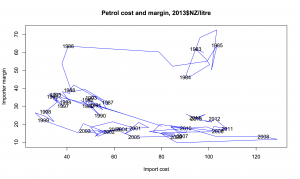More on petrol prices
I posted a version of this graph with ten years of weekly data, and Mark Stockdale pointed out there are quarterly data back to 1983 (isn’t official data wonderful?). You’ll need to click the graph to embiggen for easy viewing.
The horizontal axis is the import cost plus freight and insurance (with CPI adjustments to 2013 NZ dollars), and the vertical axis is the importer margin, which covers transport and sale costs within New Zealand, and profit. The idea is that local costs are typically slowly varying, so that short-term variation in margin tracks short-term variation in profit. The label for each year is on the data point for June.
The import cost plummeted in the early 1980s, soon followed by a drop in the importer margin. That’s presumably Rogernomics and its consequences. The cost stayed fairly stable and low in the 1990s and the margin drifted down. Then the cost increased after 1999, with the margin staying stable. We’ve recently entered a new pattern, with margin drifting upwards.
A final note: the import cost is about the same as in 1983, and so is the retail price (in real terms). The reduction in importer margin since 1983 has been almost exactly matched by an increase in taxes, though the taxes would probably be higher under a realistic world carbon price.
Thomas Lumley (@tslumley) is Professor of Biostatistics at the University of Auckland. His research interests include semiparametric models, survey sampling, statistical computing, foundations of statistics, and whatever methodological problems his medical collaborators come up with. He also blogs at Biased and Inefficient See all posts by Thomas Lumley »

“That’s presumably Rogernomics and its consequences. ”
I think you are right. Price control was removed from petrol in May 1988 and the result was a significant and persistent shrinkage of the importer margin.
Those who supported Government price control as “protecting the consumer” always failed to understand that the law set the minimum price — companies couldn’t sell below that price — and not the maximum price. In other words it protected the oil companies from each other, and protected the consumer from absolutely nothing.
Needless to say the oil companies acted to maintain the illusion it was to protect the consumer by being vocal in their condemnation of price control, while fighting Roger Douglas and his mates, as much as they could to stop it being removed!
Those were the days!!!
10 years ago